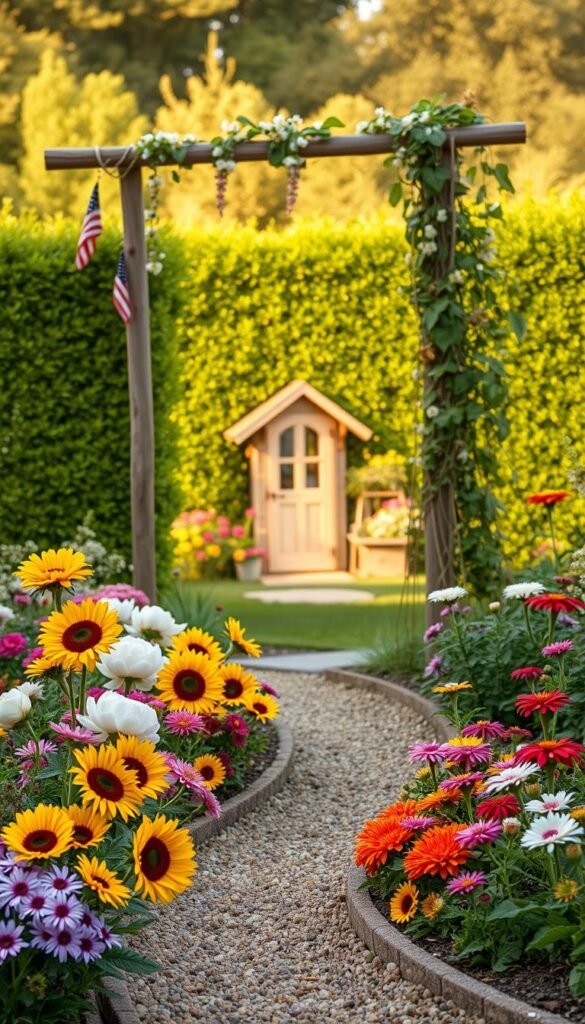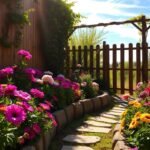Imagine stepping outside to gather fresh, colorful stems for your vase while maximizing every inch of available space. With thoughtful design, even limited areas can become thriving sources of seasonal beauty. This approach focuses on smart organization and plant choices that deliver continuous blooms without overwhelming your schedule.
Proper preparation transforms cramped corners into productive growing zones. Start by evaluating sunlight patterns and soil quality – these factors determine which varieties will flourish. Many urban growers find success with container gardening solutions that adapt to unique spatial challenges.
Compact plots offer surprising benefits when managed strategically. You’ll enjoy easier access for pruning and pest monitoring compared to sprawling beds. Focus on multi-stemmed plants that provide multiple blooms per stem, ensuring abundant harvests from minimal square footage.
This resource reveals how to balance aesthetics and functionality in tight quarters. Discover vertical growing techniques that triple your planting capacity and learn which long-lasting varieties perform best in concentrated arrangements. Whether you’re cultivating for personal enjoyment or sharing nature’s artistry with others, these methods help you achieve remarkable results.
Introduction to Your Small Cut Flower Garden Journey
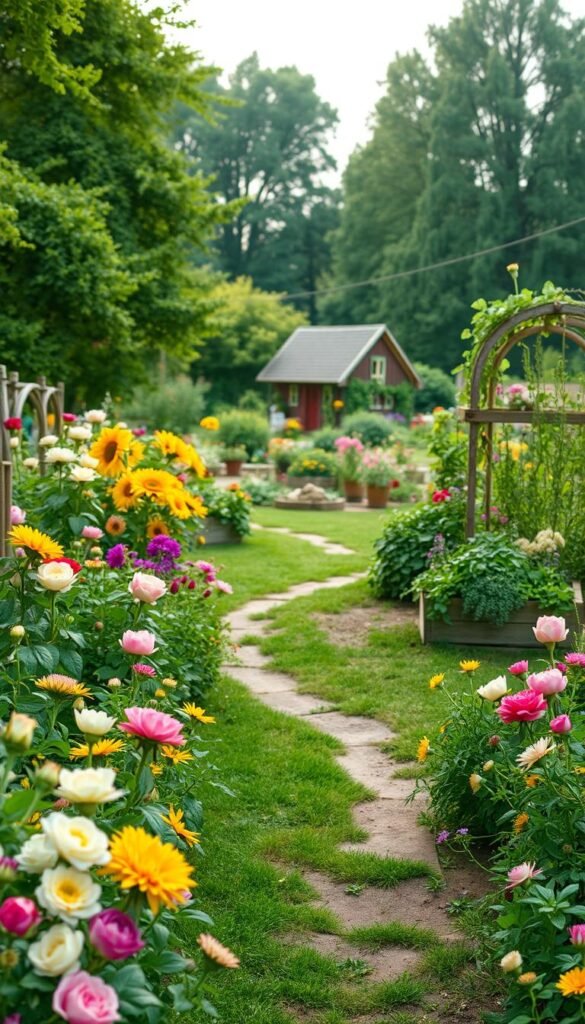
Discover how even limited spaces can burst with bouquet-ready blossoms. Growing your own cut flower garden offers daily inspiration while connecting you with nature’s rhythms. Whether you’re arranging stems for your kitchen table or sharing blooms with friends, this adventure blends creativity with practical rewards.
Compact growing areas deliver surprising perks. You’ll spend less time weeding yet enjoy closer plant observation. Try succession planting to stretch your harvest across seasons – zinnias in summer, dahlias in fall. Many growers find that working in tight quarters sparks inventive solutions like trellised sweet peas or clustered cosmos.
| Feature | Small Plots | Large Plots |
|---|---|---|
| Maintenance | 15 mins/day | 45+ mins/day |
| Plant Variety | 8-12 types | 20+ types |
| Harvest Frequency | Weekly | Daily |
Focus on varieties bred for cutting – they last longer in vases and produce more stems. Snapdragons and sunflowers thrive in concentrated beds, while marigolds add pest-repelling benefits. Each season teaches new lessons about soil health and bloom cycles, deepening your gardening skills.
Your journey transforms ordinary patches into personalized floral studios. By year’s end, you’ll master techniques that turn constraints into catalysts for growth. Ready to create living art that refreshes your home and spirit?
Understanding the Basics of “Small Cut Flower Garden Layout: Success Strategies for Tiny Plots”
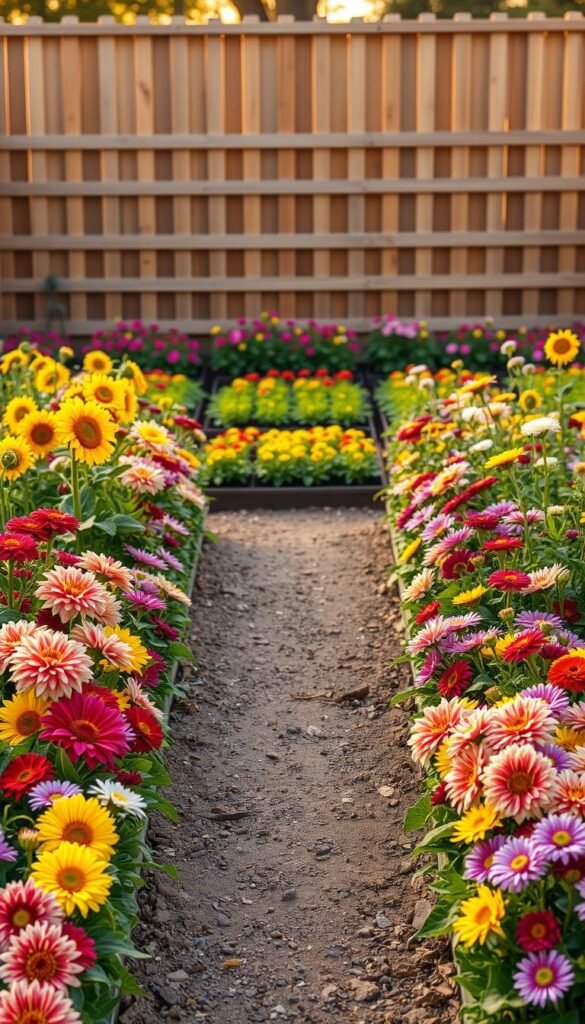
Creating a vibrant floral haven starts with rethinking traditional planting approaches. Unlike ornamental displays, harvest-focused spaces prioritize stem quality and vase longevity. Every design choice impacts your ability to gather armfuls of blooms while maintaining plant health.
Vertical growing systems and staggered planting dates transform limited areas into continuous bloom factories. Focus on varieties like snapdragons or zinnias that offer multiple stems per plant. These champions thrive in tight quarters when given proper airflow and nutrients.
| Feature | Harvest-Focused | Ornamental |
|---|---|---|
| Primary Goal | Stem Production | Visual Impact |
| Plant Spacing | 6-12″ | 12-24″ |
| Bloom Cycles | 3-5 per season | 1-2 per season |
Smart spacing lets you fit 30% more stems without crowding. Rotate crops seasonally – cool-weather stocks followed by summer cosmos. This rhythm keeps your vase filled while giving soil time to recover.
Your plants become partners in creation rather than decoration. Choose varieties bred for cutting: sturdy stems, vibrant colors, and week-long vase performance. Regular harvesting actually encourages more blooms, creating a cycle of abundance.
Remember, thoughtful planning turns constraints into creative opportunities. By aligning plant choices with your space’s unique conditions, you’ll craft arrangements that bring joy long after cutting.
Assessing Your Garden Space and Soil Quality

Transform your patch into a bloom factory by mastering two critical factors: light availability and earth composition. Sun exposure dictates which varieties will thrive, while soil health determines how vigorously they’ll grow. Start by sketching your area’s dimensions and permanent features – fences, pathways, or established trees.
Evaluating Sunlight and Natural Resources
Track sun patterns for 3 consecutive days using a simple chart. Most flowering plants need six hours of direct light – afternoon rays pack more energy than morning glow. Watch how shadows from structures or tall evergreens shift across your plot. “Morning sun areas work best for delicate blooms like sweet peas,” notes a Maryland horticulturist, “while zinnias crave those blazing midday beams.”
Identify microclimates where wind protection or heat retention occurs naturally. South-facing walls create warm pockets for early blooms, while low spots might collect frost. Mark water access points – dragging hoses across tight spaces wastes precious gardening time.
Techniques for Effective Soil Testing
Grab a handful of earth 4″ deep. Does it crumble like chocolate cake or clump like modeling clay? Healthy soil holds shape briefly before breaking apart. For drainage checks, dig a 12″ hole and fill it with water. If it drains slower than 1″ per hour, consider raised beds.
| Test Type | Ideal Result | Quick Fix |
|---|---|---|
| pH Level | 6.0-7.0 | Add lime or sulfur |
| Nitrogen | Medium-High | Mix in composted manure |
| Drainage | 1-3″/hour | Incorporate sand/organic matter |
Boost fertility with layered amendments – fish bone meal for phosphorus in spring, shredded leaves for winter insulation. Annual soil tests prevent nutrient imbalances that stunt growth in confined areas.
Choosing the Best Location for Your Cut Flower Garden
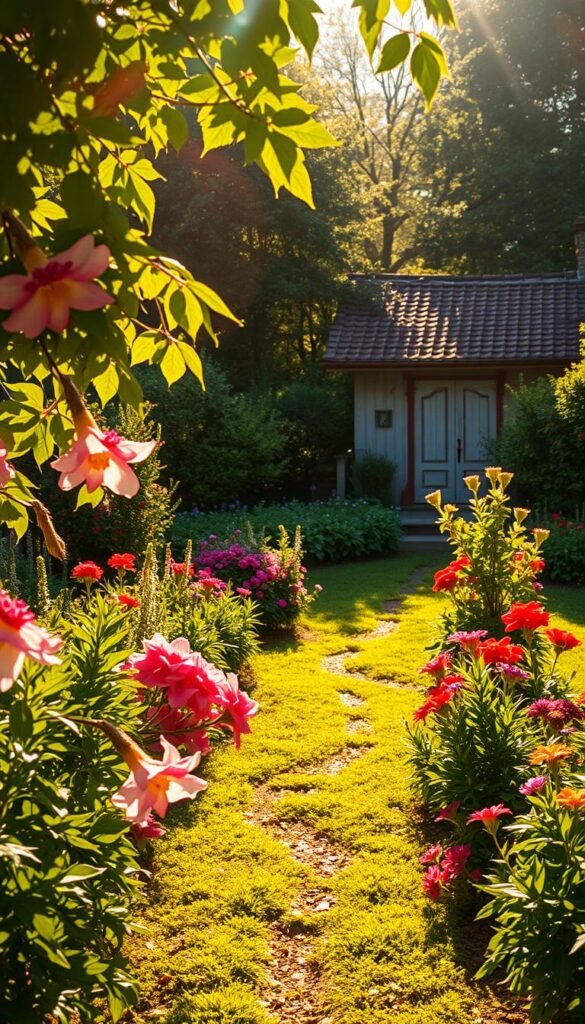
Your blooms’ performance begins with smart positioning. Observe your outdoor space like a sun tracker – notice where light lingers longest and how breezes dance through the area. These factors shape your planting decisions more than you might expect.
Analyzing Sunlight Patterns and Wind Exposure
Track sun movement across seasons using free apps like Sun Seeker. Most flowering plants crave 6+ hours of direct light – but afternoon rays differ from morning glow. A southern gardener shared: “My zinnias lean west like sun worshippers, showing where the strongest light hits.”
Wind matters more than many realize. Gusts above 15 mph can snap delicate stems. Test your space by hanging ribbons – their dance reveals airflow patterns. Shield vulnerable plants with sturdy neighbors like sunflowers or lattice panels.
Planning Around Natural Landscape Features
Turn existing elements into allies. That north-facing fence? Perfect for climbing sweet peas craving cooler roots. Rocky outcrops? Create a stunning foreground for shorter blooms. Even drainage ditches become irrigation helpers when lined with moisture-loving asters.
| Feature | Benefit | Plant Pairing |
|---|---|---|
| Stone Wall | Heat retention | Early-blooming ranunculus |
| Deciduous Tree | Summer shade | Heat-sensitive lisianthus |
| Sloped Ground | Natural drainage | Drought-tolerant yarrow |
Keep pathways wide enough for harvesting baskets but narrow enough to maximize growing space. Position water sources within 10 feet – dragging hoses through blooms damages petals. Remember: Your ideal spot balances practicality with poetic potential.
Designing a Functional Garden Layout
Transform your growing area into an efficient floral workshop through intentional spatial organization. Smart arrangements boost productivity while keeping maintenance manageable. Let’s explore how to balance practicality with visual harmony.
Defining Garden Beds and Walkways
Start by marking 30-inch-wide growing zones – this width lets you reach every plant without compacting soil. Separate beds with 18-inch pathways using materials like crushed granite or cedar chips. Clear edges prevent weed invasion and create crisp visual lines.
Group sun-loving zinnias and drought-tolerant yarrow in separate zones. This clustering simplifies watering routines and pest management. A Vermont grower shares: “Organizing by water needs cut my irrigation time by half.”
| Material | Durability | Cost | Maintenance |
|---|---|---|---|
| Gravel | High | $$ | Annual leveling |
| Wood Chips | Medium | $ | Bi-yearly refresh |
| Flagstone | Very High | $$$ | Minimal |
| Mulch | Low | $ | Seasonal replacement |
Utilizing Graph Paper and Visual Planners
Sketch scaled designs before digging. One square could equal six inches – this helps test different configurations. Many find success using digital planning tools that simulate plant growth patterns.
Color-code your draft by bloom seasons. Early spring crocuses might occupy spaces later filled by autumn chrysanthemums. This method reveals hidden opportunities for succession planting.
Remember to leave expansion room for future varieties. Even compact areas evolve as you discover new favorites. Your layout becomes a living blueprint that adapts with each season’s lessons.
Calculating the Space Needed for Your Flower Seeds
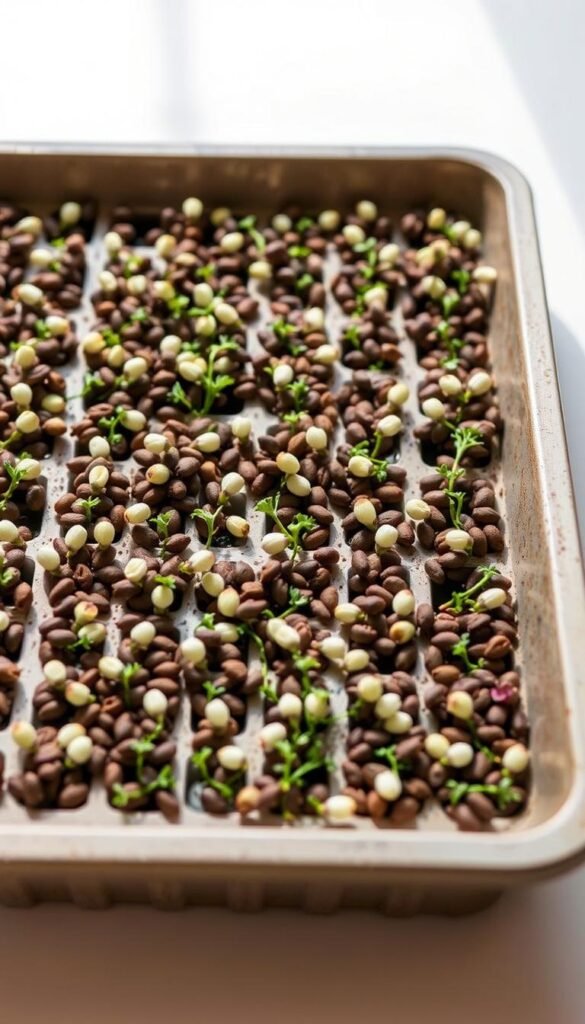
Planning your seed orders starts with precise measurements. Grab a tape measure and sketchpad to map your growing area’s exact dimensions. This step prevents overcrowding and ensures every plant gets the space it needs to flourish.
Seed packets reveal critical details – circle the mature plant size and spacing requirements first. Most annuals need 6-8 inches between stems for proper airflow. A veteran grower notes: “Tight packing invites disease, while generous spacing boosts stem quality.”
| Plant Type | Recommended Spacing | Yield Impact |
|---|---|---|
| Zinnias | 8-12″ | 15-20 stems/plant |
| Marigolds | 6-8″ | 10-15 blooms/plant |
| Snapdragons | 9-12″ | 5-8 spikes/plant |
| Cosmos | 12-18″ | 25+ flowers/plant |
Row spacing matters too. Allow 15 inches between planting lines for easy access. Narrow pathways to 10 inches if using vertical supports like obelisks. This tweak adds room for 3 extra plants per square foot.
Track succession dates in your gardening app. Fast-growing calendula can follow spring bulbs, maximizing bed usage. Calculate seed quantities by dividing available space by each variety’s footprint – round up for germination insurance.
Deciding Which Flower Seeds to Order
Crafting stunning bouquets begins with strategic seed selection. Focus on five key bloom types: eye-catching focals, vertical spikes, circular discs, delicate fillers, and wispy accents. This mix ensures your arrangements have structure, movement, and depth. Pairing seasonal stars with reliable performers creates year-round cutting potential.
Seasonal Flower Options and Benefits
Spring seeds kickstart your growing season with cool-weather champions. Snapdragons offer tower-like spikes, while larkspur adds feathery texture. Bachelor’s buttons thrive in early warmth, their cornflower-blue blooms lasting weeks in vases.
Summer’s heat brings bold choices like zinnias and sunflowers. These drought-tolerant varieties produce nonstop flowers until frost. For fall, plant chrysanthemums and strawflowers – their sturdy petals withstand chilly nights beautifully.
Popular Cut Flowers for Beginner Gardeners
Start with foolproof varieties that forgive learning curves. Cosmos tosses out daisy-like blooms with minimal care, while sweet peas climb trellises scenting the air. Marigolds pull double duty – their vibrant petals repel pests naturally.
Prioritize long vase life when choosing seeds. Zinnias stay crisp for 10+ days, and strawflowers maintain color when dried. These low-fuss picks build confidence while filling your cutting basket reliably.

